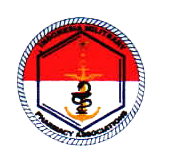CLAUSEWITZ IN THE ERA OF AUTONOMOUS WAR: THE RELEVANCE OF CLASSICAL STRATEGIES IN THE DYNAMICS OF TECHNOLOGICAL CONFLICT
(1) Dislitbang TNI AD
(*) Corresponding Author
Abstract
Carl von Clausewitz's strategic thinking, in On War, remains a fundamental reference in the study of war and military strategy. However, the emergence of advanced technologies such as drones, artificial intelligence (AI), autonomous weapons, and cyber warfare has introduced significant challenges to the classical application of Carl von Clausewitz's thinking. The purpose of this research is to revisit the relationship between four core Clausewitzian concepts: the trinity of war, the fog of war, political dominance, and the center of gravity, by reinterpreting these concepts in the context of technology driven conflict. Through a qualitative approach based on literature and theoretical criticism, this study also evaluates the limitations of Clausewitzian theory using the Russian-Ukrainian war as a case study that illustrates the tension between classical strategy and autonomous warfare. Although the tools and methods of warfare have evolved, the fundamental nature of war as a violent and uncertain political phenomenon remains unchanged. The findings of this research confirm that Clausewitz's principles still hold strategic value when applied contextually and adaptively. This article offers an original cross-disciplinary conceptual framework that integrates classical theory with AI-based conflict, ethics, and technological transformation, providing a unified analytical perspective for understanding future warfare.
Keywords
Full Text:
PDFReferences
Arquilla, J., & Ronfeldt, D. (1993). Cyberwar is coming! Comparative Strategy, 12(2). https://doi.org/10.1080/01495939308402915
Ashraf, N. (2025). The Paradox of Cyber Warfare and Clausewitz’s Conception of War. NUST Journal of International Peace & Stability, 8(1), 17–29. https://doi.org/10.37540/njips.v8i1.183
Bode, Ingvild., & Huelss, Hendrik. (2022). Autonomous Weapons Systems and International Norms. McGill-Queen’s University Press. https://doi.org/10.1515/9780228009245
Boulanin, V., Davison, N., Goussac, N., & Carlsson, M. P. (2020). Limits on Autonomy in Weapon Systems: Identifying Practical Elements of Human Control. https://www.sipri.org/sites/default/files/2020-06/2006_limits_of_autonomy_0.pdf
Boulanin, V., & Verbruggen, M. (2017). Mapping the Development of Autonomy in Weapon Systems. https://www.sipri.org/publications/2017/policy-reports/mapping-development-autonomy-weapon-systems
Bracey, E. N. (2025). Artificial Intelligence (AI), Politics, Military Science and the Art of Future War. Social Science, Humanities and Sustainability Research, 6(1), 20–32. https://doi.org/10.22158/sshsr.v6n1p20
Business Insider. (2024, November). Ukraine’s drones behind 80% of Russian frontline casualties: Report. https://www.businessinsider.com/ukraine-drones-behind-80-russia-frontline-casualties-report-nyt-war-2024-11
Clausewitz, C. von. (1976). On War (M. Howard, P. Paret, & B. Brodie, Eds. & Trans.). Princeton University Press.
Cole, B. (2020). Clausewitz’s Wondrous Yet Paradoxical Trinity: The Nature of War as a Complex Adaptive System. JPME Today, JFQ 96(1st Quarter 2020), 42–49.
Cummings, M. L. (2017). Artificial Intelligence and the Future of Warfare. https://www.chathamhouse.org/sites/default/files/publications/research/2017-01-26-artificial-intelligence-future-warfare-cummings-final.pdf
Davison, N. (2018). A legal perspective: Autonomous weapon systems under international humanitarian law. In UNODA Occasional Papers: Perspectives on Lethal Autonomous Weapon Systems (Vol. 30). UNODA. https://doi.org/10.18356/29a571ba-en
Dimitriu, G. (2020). Clausewitz and the politics of war: A contemporary theory. Journal of Strategic Studies, 43(5), 645–685. https://doi.org/10.1080/01402390.2018.1529567
Duguin, S., & Pavlova, P. (2023). The Role of Cyber in the Russian War against Ukraine: Its Impact and the Consequences for the Future of Armed Conflict. In Paper requested by the European Parliament’s subcommittee on Security and Defence (SEDE) (PE 702.594).
Echevarria, A. J. (2003). Clausewitz’s Center of Gravity: It’s not What We Thought. Naval War College Review, LVI(1), 108–123. https://apps.dtic.mil/sti/citations/ADA523742
Echevarria, A. J. (2007). Clausewitz and Contemporary War. Oxford University Press.
Enemark, C. (2024). Returning the War to Russia: Drones and Discrimination in the Defense of Ukraine. Ethics and International Affairs, 38(1), 54–63. https://doi.org/10.1017/S089267942400008X
Erickson, Jon. V. (2021). Clausewitz’s Perspective on Deterring Russian Malign Activities in Cyberspace. Military Review, September-October 2021, 6–11. https://www.armyupress.army.mil/Journals/Military-Review/English-Edition-Archives/September-October-2021/Erickson-Clausewitzs-Perspective/
Horowitz, M. C. (2018). The promise and peril of military applications of artificial intelligence. Bulletin of the Atomic Scientists, 74(6), 1–7. https://thebulletin.org/2018/04/the-promise-and-peril-of-military-applications-of-artificial-intelligence/
ICRC. (2021). International Committee of the Red Cross (ICRC) position on autonomous weapon systems: ICRC position and background paper. International Review of the Red Cross, 102(915), 1335–1349. https://doi.org/10.1017/S1816383121000564
Jacobsen, J. T. (2014). Clausewitz and the Utility of Cyberattacks in War. International Journal of Cyber Warfare and Terrorism (IJCWT), 4(4), 1–16. https://doi.org/10.4018/ijcwt.2014100101
Lucas, G. (2020). Ethics and Military Strategy in the 21st Century: MovingBeyond Clausewitz. Routledge. https://www.routledge.com/Ethics-and-Military-Strategy-in-the-21st-Century-Moving-Beyond-Clausewitz/LucasJr/p/book/9781138731097
Lucas, G. (2022). Law, Ethics and Emerging Military Technologies: Confronting Disruptive Innovation (1st ed.). Routledge. https://doi.org/10.4324/9781003273912
McFarland, T. (2022). Reconciling trust and control in the military use of artificial intelligence. International Journal of Law and Information Technology, 30(4), 472–483. https://doi.org/10.1093/ijlit/eaad008
Menthe, L., Zhang, L. A., Geist, E., Steier, J., Frank, A. B., Hegewald, E. Van, Briggs, G. J., Scholl, K., Ashpari, Y., & Jacques, A. (2024). Understanding the Limits of Artificial Intelligence for Warfighters: Volume 1, Summary. RAND Corporation. https://doi.org/10.7249/RRA1722-1
Meyer, E. L. (2022). The centre of gravity concept: contemporary theories, comparison, and implications. Defence Studies, 22(3), 327–353. https://doi.org/10.1080/14702436.2022.2030715
Rauti, S. (2020). Controlling Uncertainty with Proactive Cyber Defense: A Clausewitzian Perspective. In S. Thampi, G. Martinez Perez, R. Ko, & D. Rawat (Eds.), Security in Computing and Communications. SSCC 2019. Communications in Computer and Information Science (Vol. 1208): Vol. 1208 CCIS (pp. 335–347). Springer, Singapore. https://doi.org/10.1007/978-981-15-4825-3_27
Rid, T. (2012). Cyber War Will Not Take Place. Journal of Strategic Studies, 35(1), 5–2. https://doi.org/10.1080/01402390.2011.608939
Samus, M. (2024). Drone-Centric Warfare. Russia’s War in Ukraine, International Centre for Defence and Security, Estonia, 2(7). https://icds.ee/en/russias-war-in-ukraine-drone-centric-warfare/
Sayler, K. M. (2024). Emerging Military Technologies: Background and Issues for Congress. In Congressional Research Service. https://www.congress.gov/crs-product/R46458
Scharre, P. (2016). Autonomous Weapons and Operational Risk: Ethical Autonomy Project. https://www.cnas.org/publications/reports/autonomous-weapons-and-operational-risk
Scharre, P. (2018). Army of None: Autonomous Weapons and the Future of War. W. W. Norton.
Shah, S. R., Ahmed, F., & Khan, R. (2018). Writing a Critical Review of Literature: A Practical Guide for English Graduate Students. Global Language Review, III, 136–153. https://doi.org/10.31703/glr.2018(iii-i).09
Šlebir, M. (2022). Re-examining the center of gravity: Theoretical and structural analysis of the concept. Revista Cientifica General Jose Maria Cordova, 20(40), 1025–1044. https://doi.org/10.21830/19006586.979
Taddeo, M. (2016). Just Information Warfare. Topoi, 35(1), 213–224. https://doi.org/10.1007/s11245-014-9245-8
Templier, M., & Paré, G. (2015). A framework for guiding and evaluating literature reviews. Communications of the Association for Information Systems, 37(Paper 6), 112–137. https://doi.org/10.17705/1cais.03706
Tsotniashvili, Z. (2024). Defining the Rules of Engagement: Legal and Ethical Standards in Cyber Conflict. Journal of Digital Sociohumanities, 1(2), 119–132. https://doi.org/10.25077/jds.1.2.119-132.2024
Tyson Brown, Z. (2024). Future of Intelligence: “The Incalculable Element”: The Promise and Peril of Artificial Intelligence. Studies in Intelligence, 68(1 (Extracts, March 2024)). https://www.cia.gov/resources/csi/static/643e18ba5bf779749a14059019db53b2/Article-The-Promise-and-Peril-of-Artificial-Intelligence-Studies-68-1-March-2024.pdf
UN Human Rights Monitoring Mission in Ukraine (UN-HRMMU). (2025, February 11). Short-range drones: The deadliest threat to civilians in Ukraine. News.Un.Org. https://news.un.org/en/story/2025/02/1160016
Valeriano, B., Jensen, B., & Maness, R. C. (2018). Cyber Strategy: The Evolving Character of Power and Coercion. In Cyber Strategy: The Evolving Character of Power and Coercion. Oxford University Press. https://doi.org/10.1093/oso/9780190618094.001.0001
Van Diggelen, J., Rowa, J., Aidman, E., & Vince, J. (2025). Designing AI-Enabled Countermeasures to Cognitive Warfare. ArXiv, abs/2504.11486. https://arxiv.org/abs/2504.11486
Winczewski, D. (2023). War in Ukraine and Enduring Relevance of the Clausewitzian Theory. Athenaeum Polskie Studia Politologiczne, 80(4). https://doi.org/10.15804/athena.2023.80.14
Y
eremyan, A., & Yeremyan, L. (2022). International Law Issues of Cyber Defense. Moscow Journal of International Law, 2, 85. https://doi.org/10.24833/0869-0049-2022-2-85-100
DOI: https://doi.org/10.33172/jpbh.v15i2.19912
Copyright (c) 2025 Hiras M. S. Turnip
INDEXED BY:
Office Address:
Lembaga Penelitian dan Pengabdian Kepada Masyarakat
Republic of Indonesia Defense University
Jl. Salemba Raya No.14, Paseban,Jakarta Pusat, Daerah Khusus Ibukota Jakarta 10440, Indonesia
Email: jurnal.unhan@idu.ac.id
Creative Commons Attribution (CC-BY-NC-SA)

This work is licensed under a Creative Commons Attribution-NonCommercial-ShareAlike 4.0 International License.
View Jurnal Pertahanan dan Bela Negara Stats





